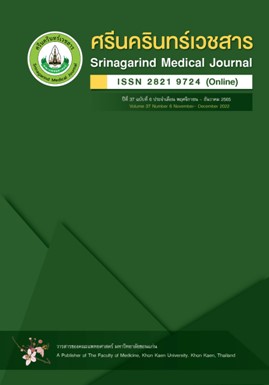การตรวจอัลตราซาวด์และความแม่นยำของการแปลผลการตรวจอัตราซาวด์ช่องท้องในผู้ป่วยที่ได้รับอุบัติเหตุโดยนักปฏิบัติการฉุกเฉินการเเพทย์
คำสำคัญ:
ความแม่นยำในการวินิจฉัย, นักปฏิบัติการฉุกเฉินการแพทย์, การตรวจอัลตราซาวด์ช่องท้องในผู้ป่วยที่ได้รับอุบัติเหตุ, อัลตราซาวด์บทคัดย่อ
หลักการและวัตถุประสงค์: การตรวจอัลตราซาวด์ช่องท้องในผู้ป่วยที่ได้รับอุบัติเหตุ (FAST) ส่งผลให้การดูแลผู้ป่วยดีขึ้นในหลายประเทศ อย่างไรก็ตามข้อมูลความแม่นยำของการตรวจ FAST โดยนักปฏิบัติการฉุกเฉินการแพทย์ในประเทศกำลังพัฒนายังมีจำนวนจำกัด การศึกษานี้มีวัตถุประสงค์เพื่อศึกษาการตรวจ FAST และความแม่นยำของการแปลผลการตรวจ FAST โดยนักปฏิบัติการฉุกเฉินการเเพทย์
วิธีการศึกษา: เป็นการศึกษาไปข้างหน้าในผู้ป่วยอุบัติเหตุที่ได้รับการตรวจ FAST ในห้องฉุกเฉิน นักปฏิบัติการฉุกเฉินการเเพทย์ที่ปฏิบัติงาน ณ ห้องฉุกเฉินโรงพยาบาลขอนแก่นได้รับการเรียนการสอนภาคทฤษฎีเป็นเวลา 2 ชั่วโมงและการสอนภาคปฏิบัติเป็นเวลา 2 ชั่วโมงตามด้วยการสอนภาคทฤษฎีผ่านสื่อวิดีโอสำหรับทบทวนความรู้โดยแพทย์ฉุกเฉินผู้เชี่ยวชาญด้านอัลตราซาวด์ จากนั้นประเมินความแม่นยำในการแปลผล FAST โดยนักปฏิบัติการฉุกเฉินการเเพทย์ รวมถึงความสามารถในการตรวจอัลตราซาวด์ในผู้ป่วยจำลอง
ผลการศึกษา: นักปฏิบัติการฉุกเฉินการเเพทย์ทั้งหมด 10 รายเข้าร่วมการศึกษา นักปฏิบัติการฉุกเฉินการเเพทย์ทำการแปลผลอัลตราซาวด์จากผู้ป่วย 200 ราย ค่าความไว ค่าความจำเพาะ ค่าพยากรณ์ผลบวก และค่าพยากรณ์ผลลบในการแปลผล FAST เมื่อเปรียบเทียบกับผลการตรวจอัลตราซาวด์โดยแพทย์ฉุกเฉินผู้เชี่ยวชาญด้านอัลตราซาวด์เท่ากับร้อยละ 91.9 (95% CI, 78.1 - 98.3), 89.6 (95% CI, 83.8 - 93.8), 66.7 (95% CI, 55.8 - 76.0), และ 98.0 (95% CI, 94.3 - 99.3) ความแม่นยำเท่ากับร้อยละ 90.0 นักปฏิบัติการฉุกเฉินการเเพทย์ทุกรายสามารถทำการตรวจอัลตราซาวด์ร้อยละ 100
สรุป: นักปฏิบัติการฉุกเฉินการเเพทย์สามารถสามารถแปลผลอัลตราซาวด์ด้วยความแม่นยำที่สูงและสามารถทำการตรวจ FAST ในผู้ป่วยจำลองหลังได้รับการสอนเป็นเวลา 4 ชั่วโมง
เอกสารอ้างอิง
References
Demetriades D, Murray J, Charalambides K, Alo K, Velmahos G, Rhee P, et al. Trauma fatalities: time and location of hospital deaths. J Am Coll Surg 2004;198(1):20–6.
Blaivas M, Sierzenski P, Theodoro D. Significant hemoperitoneum in blunt trauma victims with normal vital signs and clinical examination. Am J Emerg Med 2002;20(3):218–21.
Helm M, Kulla M, Lampl L. Advanced Trauma Life Support®. Anaesthesist 2007;56(11):1142–6.
Clarke JR, Trooskin SZ, Doshi PJ, Greenwald L, Mode CJ. Time to laparotomy for intra-abdominal bleeding from trauma does affect survival for delays up to 90 minutes. J Trauma Acute Care Surg 2002;52(3):420–5.
El Sayed MJ, Zaghrini E. Prehospital Emergency Ultrasound: A review of current clinical applications, challenges, and future implications. Emerg Med Int 2013;2013:531674.
Yates JG, Baylous D. Aeromedical ultrasound: the evaluation of point-of-care ultrasound during helicopter transport. Air Med J 2017;36(3):110–5.
Unluer EE, Yavasi O, Kara PH, Kilic TY, Vandenberk N, Kayayurt K, et al. Paramedic performed focused assesment with sonography in trauma (fast) in the emergency department. Turk J Trauma Emerg Surg 2011;17(2):113–6.
Meadley B, Olaussen A, Delorenzo A, Roder N, Martin C, St. Clair T, et al. Educational standards for training paramedics in ultrasound: a scoping review. BMC Emerg Med 2017;17(1):18.
Press GM, Miller SK, Hassan IA, Blankenship R, del Junco D, Camp E, et al. Evaluation of a training curriculum for prehospital trauma ultrasound. J Emerg Med. 2013;45(6):856–64.
Lewiss RE, Pearl M, Nomura JT, Baty G, Bengiamin R, Duprey K, et al. CORD-AEUS: consensus document for the emergency ultrasound milestone project. Acad Emerg Med. 2013;20(7):740–5.
American Institute of Ultrasound in Medicine; American College of Emergency Physicians. AIUM practice guideline for the performance of the focused assessment with sonography for trauma (FAST) examination. J Ultrasound Med. 2014;33(11):2047–56.
Daniel W Wayne. Biostatistics: A Foundation of Analysis in the Health Sciences. 6th ed. New York: John Wiley&Sons; 1995:180.
Buaprasert P, Sri-On J, Sukhuntee J, Asawajaroenkul R, Buanhong O, Khiaodee T, et al. Diagnostic accuracy of extended focused assessment with sonography for trauma performed by paramedic students: a simulation-based pilot study. Open Access Emerg Med 2021;13:249–56.
Waterman B, Aarsen KV, Lewell M, Tien H, Myslik F, Peddle M, et al. Abdominal ultrasound image acquisition and interpretation by novice practitioners after minimal training on a simulated patient model. Can J Emerg Med 2020;22(S2):S62–6.
Boniface KS, Shokoohi H, Smith ER, Scantlebury K. Tele-ultrasound and paramedics: real-time remote physician guidance of the Focused Assessment With Sonography for Trauma examination. Am J Emerg Med. 2011;29(5):477–81.
Heegaard W, Hildebrandt D, Spear D, Chason K, Nelson B, Ho J. Prehospital ultrasound by paramedics: results of field trial. Acad Emerg Med 2010;17(6):624–30.
Prathep S, Sriplung H, Phuenpathom N, Zunt J, Hirunpat S, Vavilala MS. Characteristics and outcomes of thai patients hospitalized with severe traumatic brain injury between 2009 and 2011. J Med Assoc Thai 2017;100(8):7.
Raza M, Abbas Y, Devi V, Prasad KVS, Rizk KN, Nair PP. Non-operative management of abdominal trauma – a 10 years review. World J Emerg Surg 2013;8:14.
Leppäniemi A. Nonoperative management of solid abdominal organ injuries: From past to present. Scand J Surg 2019;108(2):95–100.
ดาวน์โหลด
เผยแพร่แล้ว
รูปแบบการอ้างอิง
ฉบับ
ประเภทบทความ
สัญญาอนุญาต
ลิขสิทธิ์ (c) 2022 ศรีนครินทร์เวชสาร

อนุญาตภายใต้เงื่อนไข Creative Commons Attribution-NonCommercial-NoDerivatives 4.0 International License.




